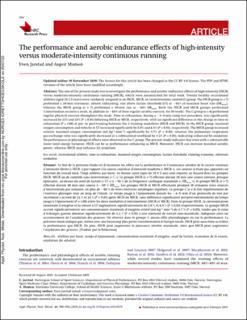| dc.contributor.author | Jarstad, Even | |
| dc.contributor.author | Mamen, Asgeir | |
| dc.date.accessioned | 2022-10-27T13:48:15Z | |
| dc.date.available | 2022-10-27T13:48:15Z | |
| dc.date.created | 2019-10-07T07:04:59Z | |
| dc.date.issued | 2019 | |
| dc.identifier.citation | Applied Physiology, Nutrition and Metabolism. 2019, 44 (9), 990-996. | en_US |
| dc.identifier.issn | 1715-5312 | |
| dc.identifier.uri | https://hdl.handle.net/11250/3028688 | |
| dc.description.abstract | The aim of the present study was to investigate the performance and aerobic endurance effects of high-intensity (HICR) versus moderate-intensity continuous running (MICR), which were nonmatched for total work. Twenty healthy recreational athletes (aged 28 ± 5 years) were randomly assigned to an HICR, MICR, or no-intervention control (C) group. The HICR group (n = 7) performed a 20-min strenuous, almost exhausting, run above lactate threshold (LT) at ∼88% of maximal heart rate (HRmax), whereas the MICR group (n = 7) performed a 40-min run at ∼80% HRmax. Both the HICR and MICR groups performed 3 intervention sessions a week, in addition to ∼60% of their regular aerobic exercise, for 10 weeks. The C group (n = 6) performed regular physical exercise throughout the study. Time to exhaustion, during a ∼4–8-min ramp test procedure, was significantly increased by 23% and 24% (P < 0.01) following HICR or MICR, respectively, with no significant difference in the change in time to exhaustion (P = 1.00) at pre- to post-training between the 2 training modalities (HICR and MICR). In the HICR group, maximal oxygen consumption and velocity at LT increased significantly by 5.0% and 6.8% (P < 0.01), respectively. The MICR group increased relative maximal oxygen consumption (mL·kg−1·min−1) significantly by 4.7% (P < 0.05), whereas the pulmonary respiratory gas-exchange ratio was significantly decreased at a submaximal workload by 4.2% (P < 0.01), indicating enhanced fat oxidation. No performance or physiological effects were observed in the C group. The present study indicates that even with a substantially lower total energy turnover, HICR can be as performance enhancing as MICR. Moreover, HICR can increase maximal aerobic power, whereas MICR may enhance fat oxidation. | en_US |
| dc.description.sponsorship | The authors would like to thank Frank Ingjer, Professor Emeritus of Sports Physiology, Erlend Hem, academic administrator of the
test laboratory at Olympiatoppen, and Svein Leirstein, physiology laboratory engineer at NIH, for eminent guidance during this
study. For excellent statistical guidance, the authors would like to thank Professor Emeritus in statistics at NIH, Ingar M.K. Holme.
Further thanks go to Bjørnar S. Henriksen, Product Manager, and Torgeir Langholen, Service Director, at Timik Medical (Oslo, Norway), for providing service manuals and worthy assistance regarding technical questions about the metabolic measuring systems, Oxycon Champion and Pro. For copy editing, the authors wish to thank John Bratås Hurry, MSc, physical therapist, of the Norwegian Sports Medicine Clinic, and Paul Farmer of Paul Farmer Translations for excellent assistance. Furthermore, the authors wish to thank the Department of Physical Performance at NIH for funding the present study and providing necessary test equipment. Finally, the authors would also like to thank the participants for their contribution to this study. The present study was supported by the Department of Physical Performance at NIH. | en_US |
| dc.language.iso | eng | en_US |
| dc.rights | Navngivelse-DelPåSammeVilkår 4.0 Internasjonal | * |
| dc.rights.uri | http://creativecommons.org/licenses/by-sa/4.0/deed.no | * |
| dc.subject | utholdenhet | en_US |
| dc.subject | løping | en_US |
| dc.subject | maksimalt oksygenopptak | en_US |
| dc.title | The performance and aerobic endurance effects of high-intensity versus moderate-intensity continuous running | en_US |
| dc.type | Peer reviewed | en_US |
| dc.type | Journal article | en_US |
| dc.description.version | publishedVersion | en_US |
| dc.rights.holder | Copyright remains with the author(s) or their institution(s). | en_US |
| dc.source.pagenumber | 990-996 | en_US |
| dc.source.volume | 44 | en_US |
| dc.source.journal | Applied Physiology, Nutrition and Metabolism | en_US |
| dc.source.issue | 9 | en_US |
| dc.identifier.doi | 10.1139/apnm-2018-0575 | |
| dc.identifier.cristin | 1734269 | |
| cristin.ispublished | true | |
| cristin.fulltext | original | |
| cristin.qualitycode | 1 | |

